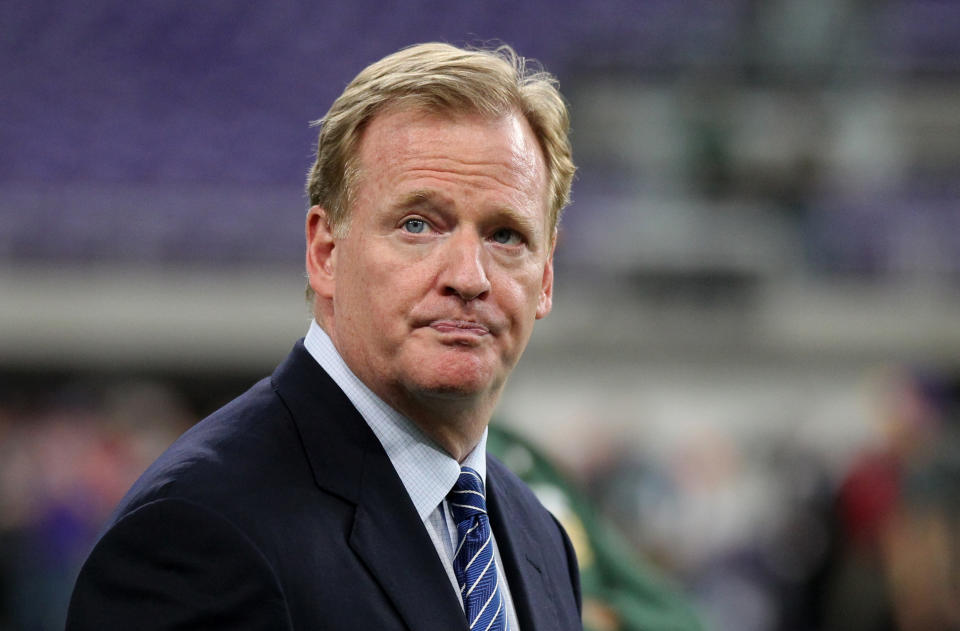NFL ratings dip forces TV networks to repay advertisers

The NFL’s television ratings decline this season is beginning to make a dent in the bottom line for major networks. Broadcasters like CBS and NBC saw sharp increases in audience deficiency units (ADUs), or “makegoods,” which are payments they must make to advertisers when ads do not receive the promised volume of impressions.
In other words, fewer people watching football means fewer eyeballs to see ads, and the networks that broadcast NFL games are paying the price.
The major football networks all took a major hit last month in NFL ad revenue—the money they bring in from advertisers that pay for air time during football games.
In the month of November, NBC’s NFL ad revenue sunk 17% compared to last year, according to new data from the Standard Media Index. CBS saw a decline of 26% (earlier this month, AdWeek points out, CBS chairman Les Moonves boasted at a UBS event that “there have been no makegoods” on any of the network’s NFL broadcasts this season). Fox saw a 34% decline in its NFL ad revenue.
To be sure, some of these networks have less football to show this year, and thus less ad space to sell. CBS is showing one less NFL game this season than last season, and Fox is showing three fewer games.
But NBC is showing the same number of games as last season, and NBC saw the biggest decline of the three. It was because of makegoods.
The makegoods that networks must hand to advertisers come in the form of free airtime—they repay their obligation by giving the advertisers ad space in a different slot. SMI, which tracks more than 70 percent of all national TV ad spending, found that NBC and CBS gave away 20% of inventory as ADUs in November 2016, compared to just 5.2% and 11%, respectively, a year earlier.
There is no public consensus over exactly why football has steadily lost viewers this season. The league’s official stance early on was that the election cycle was distracting from football, but six weeks after the election, ratings have continued to fall.
Industry experts (and President-elect Donald Trump) have pinned the decline on everything from poor matchups on the field, to the availability of highlights on social media, to the crackdown on player touchdown celebrations, to outrage over the national anthem protests by Colin Kaepernick and other players.
But now the struggles of America’s national pastime have begun to affect the bottom line for networks, eating into what would have otherwise been a 5.3% increase for a TV industry that is combatting its own demons in the shape of other streaming platforms. In November 2016, the overall TV market was down -2.4% year over year.
“November was a fascinating one for the sector with a lot of moving parts. The final days of election coverage, a challenging football season, and a revitalized retail sector all contributed to the market delivering a modest gain,” said James Fennessy, CEO of Standard Media Index, in a statement. “Poor football ratings earlier in the season, combined with fewer games this month, finally caught up with the major broadcasters.”
Though the major networks have all taken an NFL ratings hit, Fox has been able to mitigate some of the damage with a small handful of big games, most often featuring the Dallas Cowboys, the No. 1 team in the NFC. The Thanksgiving game between the Dallas Cowboys and Washington Redskins was the most-watched regular season NFL game in FOX Sports history, according to the network.
A 30-second ad on the three major networks still commands big money, averaging about $590,060 per unit, according to SMI.
The NFL is well aware of its ratings issue. Last week, the league announced it will experiment with the frequency of ad breaks during its Week 16 games, and with the number of ads that show during those breaks. The hope is that viewers will return.
To be sure, football isn’t going anywhere, and some experts downplay the current crisis. CBS chief research officer David Poltrack told investors at a conference this month that although the fumble in ratings was “quite a shock,” there is still “no reason to conclude a seminal change” has taken place in the appeal of TV’s most popular sport.
—
Laura Sanicola is a reporter at Yahoo Finance.
Read more:
The most improved state of 2016
How GAP can turn things around in 2017
The NFL looks to virtual reality to grow its audience
Connected TVs could be the ‘next frontier’ in digital advertising
